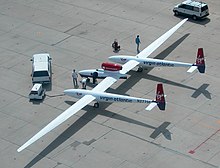Flight route
The flight route is the distance (as the crow flies ) between the take-off and landing sites that an aircraft overcomes during a flight . Depending on the flight route selected, the route actually flown can be significantly longer than the theoretical flight route: holding patterns , flying around thunderstorms or control zones and the search for updrafts necessary in gliding are not part of the actual flight route.
The flight duration , on the other hand, includes these influences of flight meteorology and is even decisive in gliding. In powered flight , however, fuel consumption usually limits the possible flight duration. In the development of aviation, there were several competitions where the goal was not the route flown, but the longest flight duration .
Commercial aviation
In commercial aviation a colloquial distinction is made between short, medium and long-haul flights; the term ultra- long-haul flight is occasionally used for particularly long flights . There is no internationally valid definition that stipulates the number of kilometers flown from which a flight is classified as a short, medium, long or ultra long haul flight. Subjective feelings and assessments also play a role here.
In the EU Air Passenger Rights Regulation , routes are classified as follows:
- Distances up to 1500 km
- Distances over 1500 to 3500 km
- Routes over 3500 km
Other definitions also include the duration of the flight, as the following example from the Aviation Handbook shows:
- Short distance: up to 1000 km and 2 hours
- Medium distance: up to 3000 km and 3.5 hours
- Long distance: over 3000 km and 3.5 hours
With the efficiency of airplanes and increasing passenger numbers, it makes sense to fly longer routes. Since October 2018, Singapore Airlines has been operating the longest and furthest flight - ever - from Singapore Changi (SIN) to New York - Newark (EWR): 16,600 km to Singapore and 15,344 km to Newark are flown nonstop in around 18 hours.
Flight route and aircraft
Based on the route classification, a rough distinction is made between short , medium and long-haul aircraft . There is a strong correlation between the two : certain routes can only be mastered with certain types of aircraft (today's turboprop aircraft are not designed for long-haul flights), on other routes the use of certain types of aircraft does not make economic sense (e.g. using an Airbus A380 on a domestic German one Flight route).
The choice of aircraft for a flight does not only depend on the distance to be covered , but also on the selected route (see e.g. ETOPS ).
General aviation
In the general aviation are flight paths individually depending on the purpose of each flight planned . The maximum possible flight route is theoretically only dependent on the range of the type of aircraft used.
The actual flight distance can be a few kilometers (e.g. for sightseeing flights ) up to several thousand kilometers (e.g. when traveling with business aircraft ). In extreme cases, a non-stop - world flight can be achieved km routes beyond the 40,000. One example of this is the record flight of the Voyager , which covered a distance of 40,212 km in December 1986.
The flight route is of greater relevance for the training of pilots: Depending on the desired flight license , cross-country flights with a specified minimum flight route must be carried out within the training . For the private pilot's license in Germany, for example, an overland flight of at least 270 km solo must be completed at the end of the training .
Gliding
When flying cross-country with gliders , paragliders or hang-gliders , the pilot tries to cover the longest possible flight distance simply by using updrafts , i.e. without motor assistance. The start and destination airports are usually identical. While the flight route used to be determined on the basis of photos taken during the flight of previously determined turning points ( landmarks ), today the recordings of the logger carried are used for this purpose .
Aviation
With paragliders or kites, using favorable weather conditions in combination with topography, distances of 100 km and much more can be covered. Crossing the Alps on such a cross-country flight is a particular challenge . Competitions like Dolomitenmann and X-Alps go in this direction. Slope updraft, leeward waves behind mountain ridges and thermal updrafts are used, which is why cross-country flights are mostly limited to the day with solar radiation.
Individual evidence
- ^ A b Heinrich Mensen: Handbook of Aviation . 2nd, revised edition. Springer, Berlin, Heidelberg 2013, ISBN 978-3-642-34401-5 , pp. 15 , doi : 10.1007 / 978-3-642-34402-2 .
- ↑ REGULATION (EC) No. 261/2004 OF THE EUROPEAN PARLIAMENT AND OF THE COUNCIL of February 11, 2004 on common rules for compensation and support services for passengers in the event of denied boarding and in the event of cancellation or long delay of flights and repealing the regulation (EEC ) No. 295/91 [1]
- ↑ Page no longer available , search in web archives: data of the Voyager flight in the FAI record database , accessed on August 17, 2010
- ↑ Baden-Württembergischer Luftfahrtverband eV: Training to become a pilot on motor-powered aircraft, accessed on August 17, 2010 ( Memento from January 6, 2012 in the Internet Archive )

